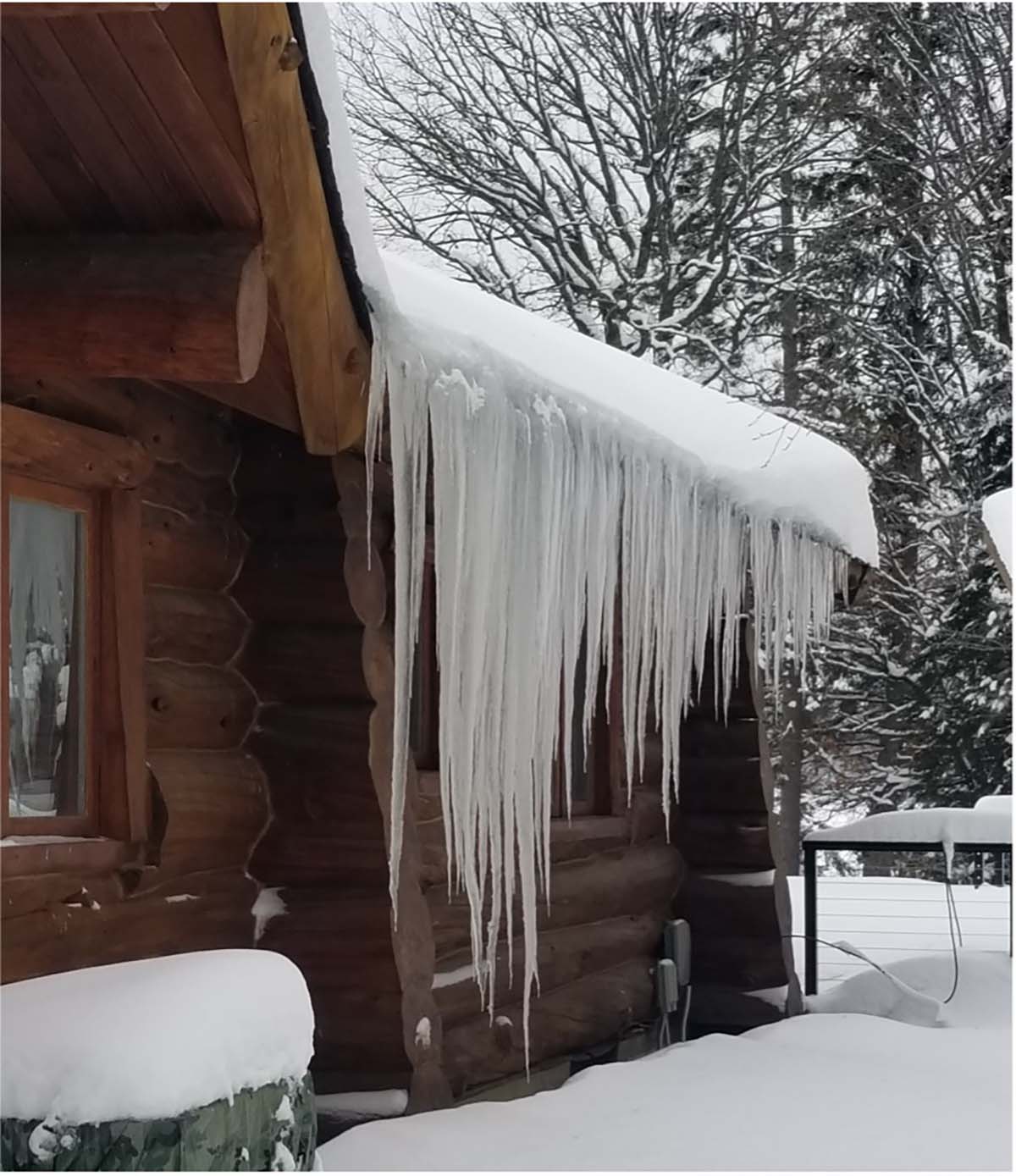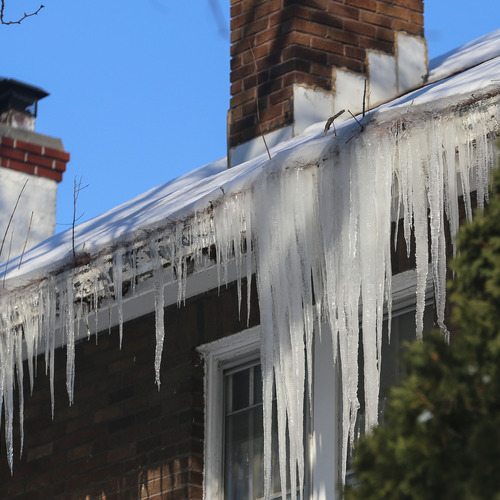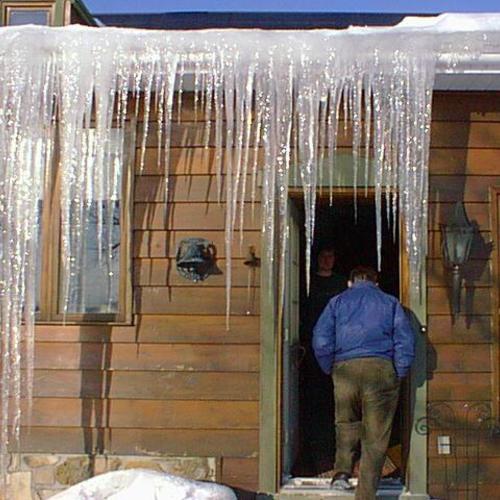
Long icicles hanging from the eaves make for great ski country advertising, but ice dams that form along the lower edges of a roof may lead to damage as melting water backs up and has no place to go but inside the house.
Writing from the Boston, Massachusetts, area, Kevin says in a Q&A post that he is aware of the danger and is looking for ways to eliminate that threat when he puts a new roof on his house.
Although the roof has been shaded until recently, the removal of some nearby trees means the two-story house will be in full sunlight during the day. The front of the house faces west.
“I’m looking to re-roof,” Kevin says, “and curious how this might impact my ice damming risk and what precautions or answers I should be looking to get from contractors, i.e. amount of ice+water shield, if needed.”
Before the trees were removed, Kevin would occasionally see ice in the front gutter, although the ice did not creep very far up the roof. He also noticed a little ice accumulation in the shadows around the roof dormers.
“Again, never water in the home,” he adds, “but occurred under more shady conditions with a lot of snow as well. I probably should have roof raked that area in hindsight.”
Does the choice of roof cladding have anything to do with ice dams? That’s the question for this Q&A Spotlight.
Solar gain is not the problem
Air leaks and a lack of insulation are the principal causes of ice dams, not the type of roof cladding, writes GBA editor Brian Pontolilo. Nor is the amount of sunlight falling on the roof a major contributor to the problem.
“Solar gain could definitely cause some…
Weekly Newsletter
Get building science and energy efficiency advice, plus special offers, in your inbox.

This article is only available to GBA Prime Members
Sign up for a free trial and get instant access to this article as well as GBA’s complete library of premium articles and construction details.
Start Free TrialAlready a member? Log in















12 Comments
A pleasant surprise when I visited the homepage. Thanks for featuring my home and I’ll be sure to update if I discover any issues with the sheathing from the open cell when we settle on a roofer. Takeaways for me are 2 strips of I+W including valleys (I’ll look in to the math above the porch), getting a blower door test, blowing in insulation over the porch, and repainting finished attic with vapor barrier paint. Hoping to get that uninsulated foundation up to R-15 soon...
Thanks again,
Kevin (Brookline)
I've seen ice dams form with the high-desert southwest sun hitting the roof during the day, melting the snow and then the melted snow refreezes at night. No leakage happens as the panel is watertight with no exposed entry points as it's a standing seam metal roof with no exposed fasteners. Diurnal swings of 60F during the day to 20F at night is common for high-desert southwest areas during winter. You get intense solar gain (elevation of 5,000+) during the day with 60F air temps and then nighttime temps drop into the 20's and even into the teens.
With that being said. In the above scenario, would not the geography of such areas result in ice dams being more common?
Also, would not the above mentioned metal roof be more resistant to ice dams?
Peter,
Ice dams require, first and foremost, snow laying on the roof for some period of time. In conditions like you describe, I expect the snow melts relatively quickly. And in the high desert, while there is occasional heavy snow fall, it is probably somewhat rare. Of course, this varies by location with some high-altitude locations receiving hundreds of inches of snow per year. Those are the ones most likely to see ice dams.
In my experience, temperature swings like you describe rarely cause ice dams. Since the outdoor temperatures don't drop below freezing until well after dark, the ice dam potential is reduced. It is the bright, cold days that seem to cause the most ice dams from solar exposure. If the sun is warm enough to melt snow on the roof (especially when combined with attic heating) while the temperatures are consistently below freezing, this provides the conditions that continue to feed water to the cold eaves as fast as it freezes. You need both a volume of water flowing down the roof and cold enough eaves to form the dams.
I find it interesting that most ice dam recommendations revolve around reducing the amount of heat that reaches the snow. No matter how much of this you do, the upper roof is still warmer than the eaves - so ice dams are reduced (perhaps to the point of being inconsequential) but not eliminated.
The only 100% cure (eave surface is warmer than the roof above) that I've seen is electric heat. I have seen recommendations to install a completely internal attic fan to provide better attic air mixing. Said to be quite effective, even if it never gets the eaves quite as warm as the attic peak.
Strictly speaking, ice dams aren't about heat loss (from the interior) or heat retention (in a vented attic or vented cathedral ceiling). They are about uneven heating. Part of this is caused by the natural (but not inevitable) tendency for warm air to rise.
Hey Jon, the "tendency for warm air to rise" is due to stack affect with a lack of insulation and no air sealing. All the homes I've sealed (from 1870-2010) stopped having ice dams. Three of them I pass during the week and the last few years we've had up to 3 feet of snow sitting on them for weeks. Proof is in the pudding. The last thing I'd want is wasted electricity under constant snow accumulation.
Lots of good information in the article. Raised heel rafter framing and proper insulation eliminates most ice dam problems but that needs to start at construction time. The very narrow gap where the rafter tail sits on the top plate makes insulation a challenge even if you can get to that area to work. Air leakage from within the wall exacerbates the problem if there is just fiberglass stuffed there. A good rafter vent and a plug of 2 lb. closed cell foam beneath it seems to do the trick but most homeowners won't go for something that expensive until after they have had a round or two of expensive ice damming damage.
Our house looks exactly like this one and we had ice dams for years. We insulated in the knee walls as you mention but the key to solving the issue I believe was a metal roof. We haven't had any problems since.
I’d love to see a picture as I have yet to come across one like ours. It’s 1940 outside of Boston, a couple of Sears kit homes were similar but not exact.
I think a metal roof would looks really sharp but quite the cost. Where did you get ice dams?
Stupid question: would painting rain gutters black help them thaw and generate enough heat to melt the ice dam above?
I have a south facing sloped roof on an addition, and it has terrible ice dams. Part may be due to uneven insulation, but part is also due to proximity to the boiler exhaust stack off to one side—just enough warm air blowing around to melt snow at the top of the roof. The roof is metal and there hasn’t been moisture incursion.
Codeslack,
I don't know. One way to test it might be to watch whether the snow on black cars melted appreciably faster than their lighter neighbours parked nearby.
Al Gore promised us no more snow by 2016...why bother with any of this...problem solved.
“Solar gain could definitely cause some ice dams as it happens when snow melts to water and then the water freezes,” Pontolilo says. “But I have never heard of solar gain as a significant cause of ice dams.
Actually where I live (Sun Valley, ID), that is exactly what happens. We have a few feet of snow on the roof all winter and lots of sun. So almost everyone has vented roofs or vented over roofs (cold roofs) to limit the ice dams. Joe Lstiburek says I should also insulate my eaves and move the vents to the edges, to block the heat from the sun hitting the siding (S and W especially). But I haven't seen anyone do that here and am wondering if it's worth it.
Log in or become a member to post a comment.
Sign up Log in